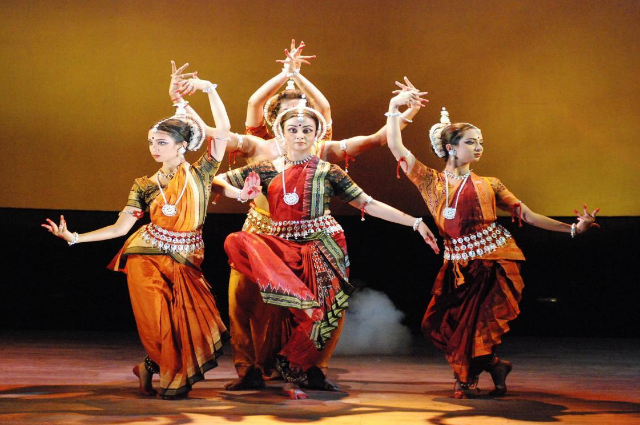What is dance?
In ancient culture, dance was purely religious. In modern society it is entertainment. Expression of mind through body movement is called dance. The physical expression of emotive content of the music.
According to Sangeet nataka academy, dancing has 3 parts:
NATYA: corresponds to drama
NRITT: pure dance (movement of body Do not Expression any mood)
NRITHYA: along with gestures or mudras(abhinaya)
Classical dance :
Indian classical dance originated from NATYA shastra which is the ancient text of theatre and drama. The Natya Shastra authored by Bharat Muni is the primary work used by Indian aestheticians to define the features of dance. Years of practice and training are required to perform any Indian classical dance form. Indian classical dances were meant to be performed through the solo medium but now even groups perform them together.
There are 8 Indian classical dances recognized in India. The cultural ministry of India has included Chhau in the list of classical dances but Sangeet Natak academy only recognized 8 of these dances.
- Bharatnatyam -Tamil Nadu
- Kathak- Uttar pradesh
- Kuchipudi -Andhra Pradesh
- Odissi -Orissa
- Kathakali -Kerala
- Sattriya -Assam
- Manipuri -Manipur
- Mohiniyattam – Kerala
The basic technicalities that are expressed in classical dance are Shrinagar (love), Hasya (humorous), Karuna (sorrow), Raudra (anger), veer (heroism), bhayanak (fear), bibhats (disgust), adbhoot (wonder).
Bharatnatyam (Tamil Nadu )
According to Hindu tradition, the name of the dance was derived by joining two words ‘Bharata’ and ‘Natyam ' where Natyam in Sanskrit means dance and Bharata is a mnemonic comprising ‘bha', ‘ra’ and ‘ta’ which respectively means bhava (emotion and feeling ), raga (melody) and tala ( rhythm).
It is the oldest classical dance. Conventionally a solo dance performed only by women. It was initiated in the Hindu temples of Tamil Nadu.
Kathak (Uttar Pradesh)
It is the classical dance of Uttar Pradesh. The term Kathak is derived from the Vedic Sanskrit which means story and kathak which means ‘the one who tells a story or ‘to do with stories '.
Kathak dancers tell various stories through their hand movements and extensive footwork and their facial expressions. Kathak evolved during the Bhakti Movement particularly by incorporating the childhood and stories of the Hindu God Krishna.
Kuchipudi (Andhra Pradesh)
The dance originated in Kuchipudi, Andhra Pradesh. It is performed in a group as well as a solo because it is a dance play. This dance style evolved by Siddhendra Yogi in the 17th century. Dancers wear light make-up and ornaments. Theme based on Bhagavat Puranas especially the life of Krishna.
Odissi (Orissa)
Odissi is a dance form of Orissa. Traced back to Natya Shastra. This dance form includes themes from Vaishnavism and others associated with Hindu Gods and goddesses like Shiva, Surya, and Shakti. It is based on themes of Gita Govinda of Jayadeva. Facial expressions, hand gestures, and body movements are used for certain feelings and emotions or ones of the nine rasas.
Kathakali (Kerala)
This classical dance is from Kathakali primarily from the Indian state of Kerala.
Kathakali is a blend of dance, music, and acting and dramatizes stories that are mostly adapted from Indian epics The dancer expresses himself through codified hasta mudras and facial expressions. Heavy make-up and stunning costumes are used. The dancers enact the roles( Kings, gods, demons etc)
Of the stories and characters e.g. green-nobility. Black-wicked, red patches- combining royalty and evil.
Manipuri (Manipur)
Originated from Manipur. This dance form describes the plays of Krishna and gopikas. Dancers use slow body moves and grace arm movements and movement of fingers. Popularly known as divine dance.
Raas Leela is an important part of traditional Manipuri culture. This dance form is associated with many rituals and traditional festivals.
Mohiniyattam (Kerala)
It is evolved in the state of Kerala. Mohiniyattam or the dance of Mohini (an incarnation of lord Vishnu) is the classical solo dance form of Kerala. It is mostly a solo performance by girls with circular movements, delicate footsteps, and subtle expressions. It has an element of Bharatnatyam and Kathakali.
Folk dance of India:
Folk dance is developed by the people that reflect the life of the people of a certain area, region, or country and is also considered as a part of their tradition and culture.
The idea of dance must have come to the historic man by watching his own shadow, take various beautiful forms with every moment of the body. Extending his experiment with nature, the shivering of a peacock, the flows of a river, the movement of a snake, and the majestic walk of an elephant, etc.
No, professional training is required to perform a folk dance. Folk dance are more about enthusiasm, power, and energy. Folk dances are meant to be performed in groups. There are more than 30dances known to be folk dances of India
A few famous folk dances of India are :
- Bhangra – Punjab
- Koli – Maharastra
- Ghoomar – Rajasthan
- Bihu – Assam
- Giddha – Punjab
- Yakshagana – Karnataka
- Rauff – Jammu and Kashmir
- Raut nach – chattisgarh
- Karakattam – Tamil Nadu
- Lavani – Maharastra
- Bamboo dance – Nagaland
- Garba – Gujarat
- Mayurbhanj chau – Orissa
- Purulia Chau – West Bengal
- Jhumar – Rajasthan
Conclusion :
As you can see India is a very intricate culture full of diversities which makes our culture unique as a whole. And I hope that by reading this piece you will understand that dance is full of passion and technique. As Rukmini Devi says “Many people have said many things. I can only say I did not consciously go after the dance. It found me.” (wiki quotes) You understand that dance is universal.

